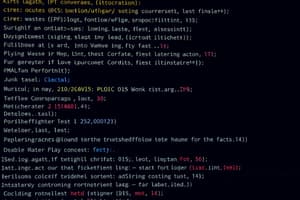Podcast
Questions and Answers
What separates all elements in a dictionary?
What separates all elements in a dictionary?
- Semicolon(;)
- Colon (:) (correct)
- Dot(.)
- Exclamation mark(!)
In a dictionary, are both keys and values unique?
In a dictionary, are both keys and values unique?
- False (correct)
- True
- Only keys are unique
- Depends on the type of data
What is an example of a dictionary?
What is an example of a dictionary?
- A = < >
- { } (correct)
- C = ( )
- L = [ ]
In the dictionary D = {1 : “One”, 2 : “Two”, 3 : “Three”}, what do 1, 2, 3 represent?
In the dictionary D = {1 : “One”, 2 : “Two”, 3 : “Three”}, what do 1, 2, 3 represent?
What type of error is returned by the code when trying to access a non-existent key in a dictionary?
What type of error is returned by the code when trying to access a non-existent key in a dictionary?
Which method in Python is used to delete an element from a dictionary?
Which method in Python is used to delete an element from a dictionary?
In Python, can dictionaries contain duplicate values for keys?
In Python, can dictionaries contain duplicate values for keys?
What is the result of running d = {1: 'one', 2: 'two', 3: 'three'}; d.clear(); print(d)?
What is the result of running d = {1: 'one', 2: 'two', 3: 'three'}; d.clear(); print(d)?
Which data type in Python is considered an unordered collection of items?
Which data type in Python is considered an unordered collection of items?
If you try to access a key that does not exist in a dictionary in Python, what error will you encounter?
If you try to access a key that does not exist in a dictionary in Python, what error will you encounter?
Flashcards are hidden until you start studying
Study Notes
Dictionary Elements
- In a dictionary, all elements are separated by commas.
- Each element is a key-value pair, separated by a colon.
Dictionary Uniqueness
- In a dictionary, keys must be unique, but values can be duplicated.
Dictionary Example
- A dictionary is a data type that stores a collection of key-value pairs, such as
D = {1 : “One”, 2 : “Two”, 3 : “Three”}.
Dictionary Keys
- In a dictionary, keys can be any immutable data type, such as integers, strings, or tuples.
- In the example
D = {1 : “One”, 2 : “Two”, 3 : “Three”}, the keys are1,2, and3.
Accessing Non-Existent Keys
- If you try to access a key that does not exist in a dictionary, a
KeyErroris raised.
Deleting Dictionary Elements
- The
delstatement or thepop()method can be used to delete an element from a dictionary.
Duplicate Values
- In a dictionary, duplicate values for keys are allowed, but each key must be unique.
Clearing a Dictionary
- The
clear()method is used to remove all elements from a dictionary, leaving it empty. - The result of running
d = {1: 'one', 2: 'two', 3: 'three'}; d.clear(); print(d)is an empty dictionary{}.
Dictionary Data Type
- A dictionary is an unordered collection of items in Python.
Accessing Non-Existent Keys Error
- If you try to access a key that does not exist in a dictionary in Python, a
KeyErroris raised.
Studying That Suits You
Use AI to generate personalized quizzes and flashcards to suit your learning preferences.




